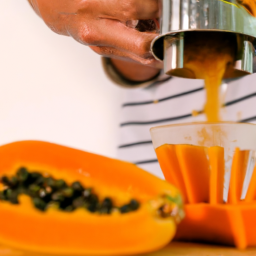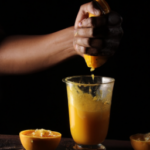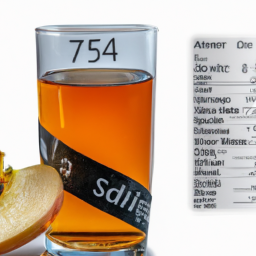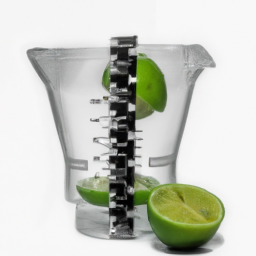Did you know that, typically, an American drinks around 2.7 cups of orange juice every week?
But what if you don’t have a juicer to make your own fresh-squeezed orange juice at home? Don’t worry, because I’m here to show you how to juice oranges without a juicer!
Using just a few basic supplies and some elbow grease, you can easily make delicious, fresh orange juice right in your own kitchen. Whether you’re a fan of sweet, tangy juice or prefer a more tart flavor, this step-by-step guide will help you get the most out of your oranges and create the perfect glass of juice every time.
So let’s get started and learn how to juice oranges like a pro!
Key Takeaways
- Wash oranges thoroughly before cutting to remove any dirt or bacteria
- Cut oranges in half from top to bottom to expose juicy flesh and make it easier to juice
- Strain juice to remove pulp and seeds using a fine mesh sieve, coffee filter, cheesecloth, or clean cotton t-shirt
- Add sweeteners like sugar or honey, or flavorings like ginger or mint, for a custom taste
Gather Your Supplies
Now, let’s get started by gathering all the supplies you’ll need to juice those sweet oranges without a juicer! First, you’ll need a sharp knife and a cutting board to prepare the oranges. Make sure the knife is sharp enough to easily cut through the thick skin of the oranges.
You’ll also need a large bowl to collect the juice and a hand juicer or a strainer. Before you start cutting the oranges, make sure to wash them thoroughly with water and a gentle scrub brush. Then, pat them dry with a clean towel. This will ensure that there are no dirt or bacteria on the oranges that could contaminate the juice.
Once you’ve gathered all the supplies and prepared the oranges, it’s time to cut them into smaller pieces.
Transitioning to the next section, start by placing the first orange on the cutting board and cutting it into quarters.
Cut the Oranges
After washing and drying the citrus fruit, simply slice the ends off and then cut it in half from top to bottom, resulting in two halves that are easy to squeeze by hand.
These orange juicing techniques are simple yet effective, and they allow you to enjoy the benefits of fresh orange juice without the need for a juicer. By cutting the oranges in half, you’re exposing the juicy flesh inside, which can be easily squeezed to extract the sweet and tangy juice.
Freshly squeezed orange juice is packed with vitamins and minerals that are essential for a healthy lifestyle. As mentioned earlier, one medium-sized orange contains about 70 milligrams of vitamin C, which is vital for boosting your immune system and keeping your skin healthy.
So, go ahead and cut those oranges in half, and let’s move on to the next step – juicing the oranges by hand.
Juice the Oranges by Hand
Get ready to enjoy the sweet and tangy taste of freshly squeezed orange juice by using your hands to extract every drop of juice from the juicy flesh of the citrus fruit. Hand juicing techniques can be just as effective as using a juicer, and there are many benefits to fresh squeezed juice that make it worth the extra effort.
-
Satisfaction: There’s something satisfying about feeling the juice squirt out from the fruit as you squeeze it, and knowing that you’re getting every last drop of flavor.
-
Control: When you juice by hand, you have more control over the amount of pulp and the overall texture of the juice.
-
Cost-effective: Hand juicing is a cost-effective alternative to buying a juicer, and it allows you to make smaller batches of juice without taking up valuable counter space.
Now that you’ve extracted all the juice from your oranges, it’s time to strain it to remove any remaining pulp or seeds.
Strain the Juice
Now that I’ve freshly squeezed orange juice, it’s time to strain it.
I always use a strainer to remove any pulp and seeds that may have made their way into the juice. If I want an even smoother consistency, I’ll use a cheesecloth to strain the juice again.
It’s a simple step, but it makes a big difference in the overall texture of the juice.
Use a Strainer to Remove Pulp and Seeds
To easily get rid of pesky pulp and seeds, strain your freshly squeezed orange juice through a fine mesh sieve – it’s like giving your juice a spa day! Using strainers creatively can help you achieve a smoother and clearer juice, but if you don’t have a fine mesh sieve, fret not! There are alternatives to strainers that you can use, such as a coffee filter, cheesecloth, or even a clean cotton t-shirt.
When straining your orange juice, here are some tips to keep in mind:
- Place the sieve over a bowl or pitcher to catch the juice.
- Use a ladle to pour the juice into the sieve, pressing down on the pulp with the back of the ladle to extract as much juice as possible.
- Clean the sieve between batches to prevent build up of pulp and seeds.
- Don’t forget to scrape the underside of the sieve to get every last drop of juice.
If using a coffee filter or cheesecloth, be sure to rinse it thoroughly beforehand to remove any residual flavors.
For a smoother consistency, use a cheesecloth to strain the juice further.
Use a Cheesecloth for a Smoother Consistency
Achieve a smoother consistency by using a cheesecloth – simply place the cloth over a bowl and pour your freshly squeezed orange juice over it, then gather the edges and twist to extract every last drop of deliciousness. Cheesecloth is a versatile and inexpensive kitchen tool that can be used for a variety of purposes, such as straining broth, making cheese, and even wrapping herbs for bouquet garni. When choosing a cheesecloth, look for a fine, tight weave that will catch all the pulp and seeds while allowing the juice to flow through easily.
To get the best flavor and yield from your oranges, choose ones that are firm, heavy for their size, and brightly colored. Avoid oranges that are soft, spongy, or have blemishes or bruises, as they may not be as juicy or flavorful. Navel oranges are a popular choice for juicing, as they are seedless and have a sweet, tangy taste. Valencia oranges are another great option, as they are juicier and have a slightly tart flavor.
Once you have your oranges and cheesecloth ready, you can move on to the next step of adding sweeteners or other flavors to your freshly squeezed juice.
Add Sweeteners or Other Flavors
Now that I’ve strained my orange juice, it’s time to add some sweetness and flavor. I like to use a little bit of sugar or honey to enhance the natural sweetness of the oranges.
If I’m feeling adventurous, I might add some freshly grated ginger or muddled mint leaves for a unique twist. Adding sweeteners or other flavors is a great way to customize your orange juice to your liking.
Sugar or Honey
Adding sugar or honey to freshly squeezed orange juice can give it a sweet twist, making it as refreshing as a cool breeze on a hot summer day. However, there are a few things to consider when choosing between sugar and honey.
-
Sugar: It’s important to note that refined sugar contains empty calories and has no nutritional value. It can also lead to health issues such as weight gain, diabetes, and heart disease. Therefore, it’s important to use sugar in moderation.
-
Honey: On the other hand, honey is a natural sweetener that’s rich in antioxidants, anti-inflammatory compounds, and has antibacterial properties. It’s also known to boost immunity and soothe sore throats. However, it’s important to keep in mind that honey is still a form of sugar and should also be used in moderation.
-
Health benefits: Both sugar and honey have their own health benefits. However, when it comes to adding sweeteners to orange juice, using a natural sweetener like honey can provide additional health benefits.
-
Moderation: Regardless of which sweetener you choose to use, it’s important to use them in moderation. Too much sugar or honey can still lead to health issues.
Now that we’ve discussed the differences between sugar and honey, let’s move on to the next sweet twist option – ginger or mint.
Ginger or Mint
Opting for either ginger or mint can provide a refreshing and invigorating twist to your freshly squeezed orange beverage. Ginger, in particular, has many benefits when added to orange juice. It can help reduce inflammation in the body, boost the immune system, and aid in digestion. Simply grate a small amount of ginger into your orange juice and mix well for a zesty and healthy drink.
Mint is another great addition to orange juice recipes. It adds a cooling sensation to the drink and can also aid in digestion. For the best results, muddle a few fresh mint leaves in the bottom of a glass before pouring in the freshly squeezed orange juice. This will release the oils in the mint and infuse the drink with its refreshing flavor.
Adding ginger or mint to your freshly squeezed orange juice can take it to the next level. After adding your desired herbs, consider chilling the orange juice for a refreshing and thirst-quenching drink.
Chill the Orange Juice
First, grab your freshly squeezed orange juice and pop it in the fridge to chill for at least 30 minutes.
There are many ways to enjoy chilled orange juice, such as drinking it straight up, mixing it with other juices, or making a refreshing smoothie. The benefits of drinking chilled orange juice are numerous, including helping to cool down your body on a hot day, providing a boost of vitamin C, and aiding in digestion.
Once your orange juice is chilled, it’s important to store any leftover juice properly. One tip is to transfer the juice to an airtight container and store it in the fridge for up to three days. Another option is to freeze the juice in ice cube trays and use them to add a burst of citrus flavor to your drinks or smoothies.
By following these simple steps, you can enjoy freshly squeezed orange juice at any time without the need for a juicer.
Store Any Leftover Juice
Properly storing your leftover orange juice is key to enjoying it later on. There are several storing techniques that you can use to keep your orange juice fresh and delicious.
One option is to transfer the juice into an airtight container and store it in the refrigerator for up to two days. This will help preserve the freshness and flavor of the juice, as well as prevent it from oxidizing and spoiling.
Another option is to add a preservative to the juice. Citric acid, vitamin C, or lemon juice are all great options that can help extend the shelf life of your orange juice. Simply add a small amount to the juice before storing it in the refrigerator. This will not only help preserve the juice, but also enhance its flavor and nutritional value.
With these storing techniques and preservative options, you can enjoy your homemade orange juice for days to come.
Now that you know how to properly store your orange juice, it’s time to experiment with different oranges. There are many types of oranges available, each with its own unique flavor and nutritional benefits.
In the next section, we’ll explore some of these options and how they can enhance your homemade orange juice.
Experiment with Different Oranges
I love experimenting with different types of oranges when making fresh juice. Navel oranges are my go-to for their sweet flavor and easy-to-peel skin.
Valencia oranges are perfect for juicing as they have a high juice content and a tangy taste.
And for a unique twist, I like to use blood oranges for their ruby-red color and slightly tart flavor.
Try using different oranges to find your perfect citrus combination.
Navel Oranges
When juicing navel oranges, it’s like squeezing sunshine into a glass. These oranges are known for their sweet and tangy flavor, making them a popular choice for juicing. Not only do they taste delicious, but they also have many health benefits.
Navel oranges are a great source of vitamin C, fiber, and antioxidants. Incorporating them into your diet can help boost your immune system and improve digestion. If you’re looking for navel orange recipes, there are plenty to choose from.
You can simply juice them for a refreshing drink, or mix them with other fruits for a tasty smoothie. They can also be used in salads, desserts, and marinades. The possibilities are endless with these versatile fruits.
Now, let’s move on to the next type of orange – the valencia orange.
Valencia Oranges
Valencia oranges are a popular choice for making marmalade due to their high pectin content and tangy flavor. These oranges are believed to have originated in Spain, specifically in the city of Valencia, and were introduced to the United States in the late 1800s. They are now grown throughout the world, with California and Florida being major producers.
In addition to marmalade, Valencia oranges are great for juicing due to their sweet and tart flavor. They’re also commonly used in salads, marinades, and baked goods. One of my favorite recipes using Valencia oranges is a citrus salad with avocado and shrimp. The combination of the tangy oranges, creamy avocado, and succulent shrimp is simply delicious.
Moving on to the next topic, blood oranges…
Blood Oranges
I hope you enjoyed learning about Valencia oranges in the previous section. Now, let’s talk about another popular orange variety called blood oranges. These oranges are known for their deep red flesh and sweet, tangy flavor. They’re a great option for juicing and can be easily incorporated into a variety of recipes.
If you’re looking for a healthy and delicious way to start your day, try making a blood orange juice. Here are a few nutritional benefits of adding blood oranges to your diet:
- High in vitamin C: One medium-sized blood orange contains approximately 70% of your daily recommended intake of vitamin C.
- Rich in antioxidants: Blood oranges are packed with antioxidants, which help to protect your cells from damage caused by harmful free radicals.
- Good source of fiber: Eating a blood orange can help to keep you feeling full and satisfied, thanks to its high fiber content.
To make a delicious blood orange juice, simply peel and segment the oranges, removing any seeds and pith. Then, add the segments to a blender or juicer and blend until smooth. You can also add other ingredients like ginger, honey, or mint to create a unique flavor profile.
Now that you know how to juice blood oranges, it’s time to try different juicing methods to find your favorite.
Try Different Juicing Methods
To switch things up, why not give different juicing methods a go? You can juice using alternatives such as a blender or food processor for a smoother juice compared to using a manual juicer. To make a smooth orange juice, simply peel the oranges and remove the seeds, then blend the fruit. Strain the juice using a fine mesh strainer or cheesecloth to remove any pulp or fibrous bits.
You can also mix and match different citrus fruits to create unique flavor combinations. For example, try juicing oranges with grapefruits or lemons for a tangy and sweet blend. Don’t be afraid to experiment and find the perfect blend for your taste. With these different juicing methods and citrus fruit options, you can enjoy your freshly squeezed orange juice in a variety of ways.
Enjoy Your Freshly Squeezed Orange Juice!
Now that you’ve tried different juicing methods, it’s time to enjoy your freshly squeezed orange juice! There’s nothing quite like the taste of a freshly squeezed orange, and knowing how to juice oranges without a juicer opens up a world of possibilities.
Plus, there are many benefits to drinking orange juice, from providing essential vitamins and minerals to boosting your immune system.
To make the most delicious orange juice, it’s important to choose the best oranges. Look for oranges that are heavy for their size and have smooth, firm skin. If you prefer sweeter juice, choose oranges with a lighter skin color, as they tend to be riper and sweeter. And if you’re looking for a tangier taste, go for oranges with a darker skin color.
Once you’ve chosen your oranges, simply cut them in half and squeeze the juice out into a glass or container. You can use a handheld juicer or even just your hands. Don’t worry if there are a few seeds or pulp in your juice – that’s just a sign that you’re getting all the natural goodness from the oranges.
So go ahead, enjoy your freshly squeezed orange juice and feel good about giving your body a healthy boost!
Frequently Asked Questions
How long does it take to juice oranges by hand?
Hand juicing tips: slice the orange in half, use a fork to loosen the flesh, then squeeze the juice into a container. Best tools for hand juicing: citrus squeezer or reamer. Time varies, but it usually takes me 2-3 minutes per orange.
Can I use a blender instead of a strainer to remove pulp?
I’ve found that using a blender to juice oranges can be a great alternative to a strainer. For a pulp-free option, blend the oranges on high speed and pour the mixture through a cheesecloth or fine mesh sieve. Blender alternatives can be just as effective as juicers, just be sure to strain the juice for a smooth texture.
How many oranges do I need to make a glass of juice?
To make a glass of orange juice, I recommend using about 3-4 medium-sized oranges. Choosing the right oranges is important for optimal flavor and juiciness. Experiment with different orange juicing techniques to find what works best for you.
Can I juice frozen oranges?
Like a kid with a popsicle, I was curious about juicing frozen oranges. But after trying various Juicing Techniques and Orange Preparation methods, I found it best to stick with fresh, room temperature oranges for optimal juice yield and flavor.
How long can I store freshly squeezed orange juice in the fridge?
Freshly squeezed orange juice can stay fresh in the fridge for up to 3 days. To preserve it longer, freeze it in an airtight container. Daily intake of freshly squeezed orange juice boosts immunity and provides a rich source of vitamins and antioxidants.
Conclusion
In conclusion, learning how to juice oranges without a juicer is a useful skill that can save you a lot of money and give you a healthier beverage option. It’s a process that requires patience, effort, and a little bit of creativity. Just like life requires us to gather our supplies, cut through obstacles, and strain out the negativity to enjoy the sweet moments.
The process of juicing oranges is a metaphor for life. It reminds us that the best things in life require a little bit of effort, but the end result is always worth it. When you experiment with different oranges and juicing methods, you are also reminded that life is full of surprises and that there are always new things to discover.
Just like how a different type of orange can give you a completely unique flavor, life can bring unexpected twists and turns that can lead to new opportunities and experiences. So, enjoy the process of juicing oranges and embrace the journey of life with open arms.
Ilana has been a vegan for over 10 years. She originally made the switch for health reasons, but soon found herself becoming more and more passionate about the ethical and environmental implications of a vegan lifestyle. Ilana is the author of The Graceful Kitchen, a blog all about veganism. She loves to cook up delicious and nutritious vegan meals, and share her recipes with others who are interested in leading a cruelty-free life. Ilana is also a strong advocate for using whole foods as the foundation of a healthy diet, and believes that going vegan is one of the best ways to achieve this.
















